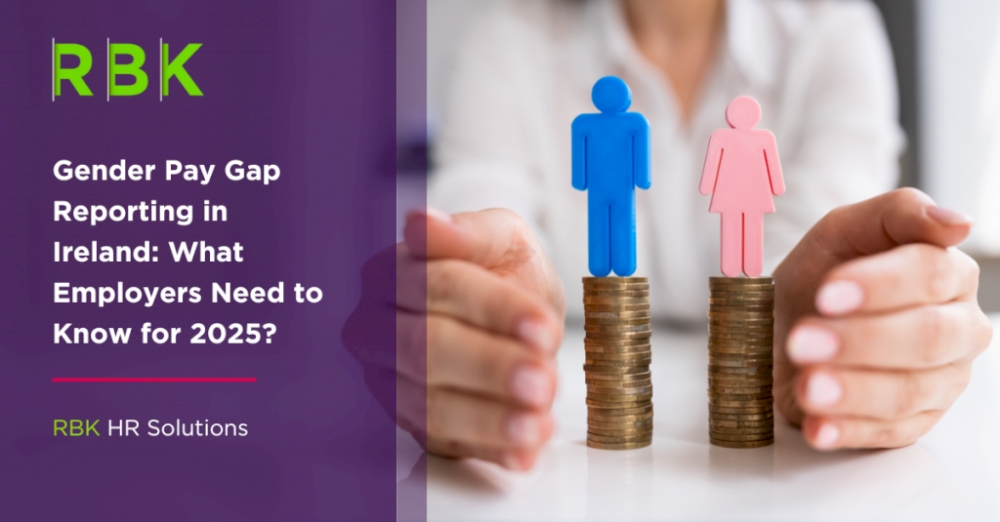From June 2025, Gender Pay Gap (GPG) reporting requirements in Ireland will expand to include all organisations with 50 or more employees. This marks a key milestone in Ireland’s efforts to improve workplace pay transparency and promote gender equality.
What is Gender Pay Gap Reporting?
Gender pay gap reporting requires organisations to calculate and publish the difference in average hourly earnings between men and women across their workforce. It’s important to distinguish this from equal pay, which refers to paying men and women the same for performing the same job. The gender pay gap instead reflects broader inequalities — such as fewer women in senior roles or a higher concentration of women in lower-paid positions — that can contribute to overall pay disparities.
The Importance of Gender Pay Gap Reporting
Publishing GPG data helps identify underlying issues that may contribute to gender-based pay disparities. It encourages employers to take a closer look at their pay structures and workplace practices, and it fosters accountability. Ultimately, transparency can support meaningful change and helps to attract and retain a more diverse workforce.
Who Must Report?
Under the Gender Pay Gap Information Act 2021, reporting requirements have been phased in:
- 2022: Employers with 250 or more employees
- 2024: Employers with 150 or more employees
- 2025: Employers with 50 or more employees
What Must Be Included in the Report?
Employers must calculate and disclose the following:
- The average difference in gross hourly earnings of male and female employees.
- Mean and median hourly pay differences between genders.
- The mean and median gender pay gap of part-time employees.
- Mean and median bonus pay differences.
- The percentage of male and female employees who received bonuses and benefits in kind.
- Percentage of male and female employees in 4 equal quartile pay bands (lower, lower middle, upper middle, upper).
In addition, employers are expected to provide a narrative explaining the causes of any gaps and the actions being taken to address them.
Additional Key Information
- Classification of who the Organisation regards as an employee and who it does not.
- Classification of who has self-identified as female and who has self-identified as male.
- Data must be collected as of a specific "snapshot date" each year.
- Information on all employees, including full-time, part-time, and those on leave.
- Information on the number of hours worked by each employee for each week within the ‘Relevant pay period’ meaning the period of 12 months ending and including the ‘Snapshot Date’.
Note: It is helpful to align this with your payroll date in June as the information has already been collated for this time period. Include Name, Start date, Gender, Job titles, Employment status (full-time, part-time, etc.), Annual gross salary, Bonuses and other financial benefits, Overtime pay, Allowances and other forms of compensation.
Timeline and Deadlines
- Snapshot date : Employers must select a date in June 2025 to capture their workforce data.
- Publication deadline : Reports must be published within 5 months of the snapshot date, typically by November 2025 .
Where to Report
In August 2025, the government is due to launch a central online reporting portal. This platform will host gender pay gap reports for all in-scope employers and be accessible to the public.
Consequences of Non-Compliance
While there are no direct financial penalties, failure to comply can result in:
- Legal enforcement: The Irish Human Rights and Equality Commission (IHREC) may apply to the courts for compliance orders.
- Employee complaints: Employees can raise complaints with the Workplace Relations Commission (WRC).
- Reputational risks: Not reporting may damage employer brand and negatively impact recruitment and retention efforts.
Steps Employers Should Take Now
To prepare for reporting, employers should:
- Audit employee pay data to ensure accuracy and completeness.
- Calculate gender pay metrics based on the required categories.
- Prepare an explanatory narrative outlining any gaps and the organisation’s response.
- Engage stakeholders internally to review findings and plan actions.
- Publish the report on the organisation’s website and via the national reporting portal.
Gender pay gap reporting is more than a regulatory requirement—it’s an opportunity for employers to demonstrate leadership in equality and inclusion. By addressing pay disparities openly, organisations can build trust, improve performance, and contribute to a more equitable workforce across Ireland.
Contact Us
For more advice and support with Gender Pay Gap Reporting or to discuss our HR services please contact a member of the RBK HR Solutions Team:
Yvonne Clarke , Head of HR Solutions – (090) 6480600
Áine Dunne, Assistant Manager - HR Solutions - (090) 6480600
Disclaimer: While every effort has been made to ensure the accuracy of information within this publication is correct at the time of going to print, RBK do not accept any responsibility for any errors, omissions or misinformation whatsoever in this publication and shall have no liability whatsoever. The information contained in this publication is not intended to be an advice on any particular matter. No reader should act on the basis of any matter contained in this publication without appropriate professional advice.


